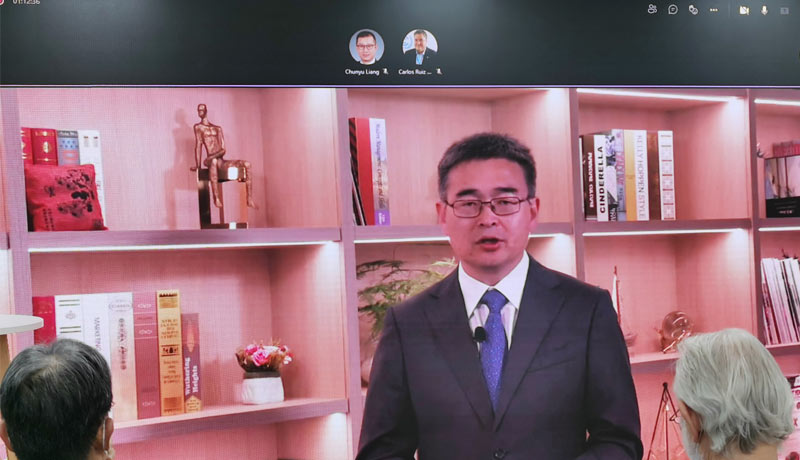Huawei initiate steps to tackle climate change with technology innovation at COP26

Dr. Fang Liangzhou, Huawei Digital Power’s Vice President and Chief Marketing Officer, recently addressed at COP26. Fang gave a virtual keynote talk on “Building a Low-Carbon Smart Society” at the UNFCCC Global Innovation Hub’s session “System Change and Climate Innovation in the Technology Industry.” According to Fang, Huawei Digital Power mixes digital and power electronics technology to assist enterprises conserve energy and minimise emissions from both power generation and consumption. Digitalization of power may reduce energy waste, enhance renewable energy output, and make transportation and cities more environmentally friendly.
Fang said, “Carbon neutrality has become a shared mission of the world. Technology innovation will play a central role in tackling climate change and achieving carbon reduction goals.”
He added, “Huawei Digital Power integrates digital and power electronics technologies, develops clean power, and enables energy digitalization to drive energy revolution for a better, greener future. We focus on converging and innovating on technologies to accelerate the digitalization of energy and enable various industries to upgrade. We aim to accelerate clean power generation, build green transportation, sites, and data centers, and work with industry partners to build a low-carbon smart society.”
According to the International Energy Agency (IEA), the main sources of worldwide carbon emissions are energy, industry, and transportation. 40% and 21% of carbon emissions come from the energy and transportation sectors, respectively. The ICT sector uses 4% of the world’s electricity. Low-carbon electricity production and use are required to attain carbon neutrality. Huawei Digital Power collaborates with partners to innovate energy production and use in order to achieve green and low-carbon outcomes:
- Huawei creates a clean power system based on renewable energy technologies like wind, solar, and energy storage in smart PV. Huawei is assisting Saudi Arabia’s Red Sea Energy Storage Project in supplying power to the entire metropolis in the Middle East. This project will utilise a 400 MW PV + 1.3 GWh energy storage system to fulfil the future energy needs of millions of people. When the project is completed, the city will be the first in the world to be powered entirely by clean PV and storage energy.
- Huawei uses a combination of digital and power electronics technology in energy digitalization to reduce consumption during energy conversion, storage, and use, boosting energy efficiency. In collaboration with China Southern Power Grid, Huawei employs artificial intelligence (AI) to detect common unsafe scenarios and transmission line problems automatically. The time it takes to do onsite work is reduced from 20 days to 2 hours thanks to a novel preventive maintenance technique based on intelligence analysis and manual judgment, resulting in an 80-fold increase in inefficiency.
- Huawei has launched a series of off-grid fuel-removal power supply solutions to help carriers accelerate network carbon neutrality and bridge the energy divide, using cabinets instead of rooms and poles instead of cabinets to simplify sites. Huawei has also launched a series of off-grid fuel-removal power supply solutions to help carriers accelerate network carbon neutrality and bridge the energy divide. For instance, a carrier in Zhejiang, China, employed Huawei Site Power high-density eMIMO technology to replace six cabinets with one, decreasing the footprint from 5 m2 to 1 m2 and increasing site energy efficiency from 85% to 96 percent. They also implemented Huawei’s green power solution, in which the company’s proprietary iPV technology helps generate 20% more electricity, allowing PV to become the primary source of power for green ICT networks and reducing carbon emissions by 8 tons per site each year.
- In data center facility, prefabrication, modularization, and intelligent technologies are used to build simplified, green, intelligent, and secure next-generation data centers. For example, Huawei’s prefabricated modular data center solution helped Wuhan quickly build an AI computing center. The center was built in 120 days and put into use in 180 days, shortening the rollout time by more than 50%. In addition, AI energy conservation technology is adopted to decrease the PUE to 1.25, which represents a saving of more than 3.4 million kWh of electricity each year. In addition, carbon dioxide emissions can be reduced by approximately 42,000 tons over the course of the lifecycle.
- In mPower, Huawei provides power domain solutions and charging infrastructure to accelerate the process of transportation electrification. For example, Huawei’s DriveONE powertrain system helped SERES build the world’s first mass-produced, high-performance electric coupe SUV with a cruising range of more than 1000 km, achieving 0–50 km/h acceleration in 1.99 seconds.
Huawei has continued to invest in decreasing carbon emissions, boosting renewable energy, contributing to a circular economy, and conserving nature through technology as part of its “Tech for a Better Planet” goal. Huawei Digital Power has assisted customers in generating 443.5 billion kWh of green power, saving 13.6 billion kWh of electricity, and reducing carbon dioxide emissions by 210 million tonnes, the equivalent of planting 290 million trees, as of September 30, 2021.
